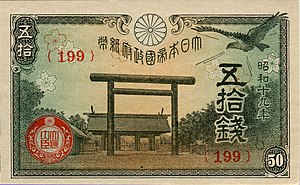
Back রাষ্ট্রীয় শিন্তৌ Bengali/Bangla Staats-Shintō German Sintoísmo estatal Spanish شینتوی حکومتی Persian Shintoïsme d'État French Shinto Negara ID Shintoismo di Stato Italian 国家神道 Japanese 국가신토 Korean Statsshinto NB
| Part of a series on |
| Shinto |
|---|
 |

State Shintō (国家神道 or 國家神道, Kokka Shintō) was Imperial Japan's ideological use of the Japanese folk religion and traditions of Shinto.[1]: 547 The state exercised control of shrine finances and training regimes for priests[2][3]: 59 [4]: 120 to strongly encourage Shinto practices that emphasized the Emperor as a divine being.[5]: 8
The State Shinto ideology emerged at the start of the Meiji era, after government officials defined freedom of religion within the Meiji Constitution.[6]: 115 Imperial scholars believed Shinto reflected the historical fact of the Emperor's divine origins rather than a religious belief, and argued that it should enjoy a privileged relationship with the Japanese state.[5]: 8 [3]: 59 The government argued that Shinto was a non-religious moral tradition and patriotic practice, to give the impression that they supported religious freedom.[3]: 59 [4]: 120 Though early Meiji-era attempts to unite Shinto and the state failed,[6]: 51 this non-religious concept of ideological Shinto was incorporated into state bureaucracy.[7]: 547 [8] Shrines were defined as patriotic, not religious, institutions, which served state purposes such as honoring the war dead;[6]: 91 this is known as Secular Shrine Theory.[9]
The state also integrated local shrines into political functions, occasionally spurring local opposition and resentment.[4]: 120 With fewer shrines financed by the state, nearly 80,000 closed or merged with neighbors.[6]: 98 [7]: 118 Many shrines and shrine organizations began to independently embrace these state directives, regardless of funding.[7]: 114 By 1940, Shinto priests risked persecution for performing traditionally "religious" Shinto ceremonies.[6]: 25 [10]: 699 Imperial Japan did not draw a distinction between ideological Shinto and traditional Shinto.[7]: 100
US military leaders introduced the term "State Shinto" to differentiate the state's ideology from traditional Shinto practices[5]: 38 in the 1945 Shinto Directive.[5]: 38 That decree established Shinto as a religion, and banned further ideological uses of Shinto by the state.[10]: 703 Controversy continues to surround the use of Shinto symbols in state functions.[2]: 428 [10]: 706 [11]
- ^ Cite error: The named reference
Fridellwas invoked but never defined (see the help page). - ^ a b Cite error: The named reference
Shibatawas invoked but never defined (see the help page). - ^ a b c Cite error: The named reference
Zhongwas invoked but never defined (see the help page). - ^ a b c Cite error: The named reference
Keenewas invoked but never defined (see the help page). - ^ a b c d Cite error: The named reference
Earhartwas invoked but never defined (see the help page). - ^ a b c d e Cite error: The named reference
Hardacrewas invoked but never defined (see the help page). - ^ a b c d Cite error: The named reference
:0was invoked but never defined (see the help page). - ^ Sakamoto, Koremaru (1993). Kokka Shinto taisei no seiritsu to tenkai. Tokyo: Kobunda. pp. 165–202.
- ^ 均, 新田 (10 August 2020). 加藤玄智の国家神道観 [Genchi Kato's view of state Shinto]. Religious Law Research (宗教法研究) (in Japanese) (14): 199–230. Archived from the original on 20 May 2023. Retrieved 1 August 2022.
- ^ a b c Cite error: The named reference
Beckfordwas invoked but never defined (see the help page). - ^ Cite error: The named reference
Loowas invoked but never defined (see the help page).